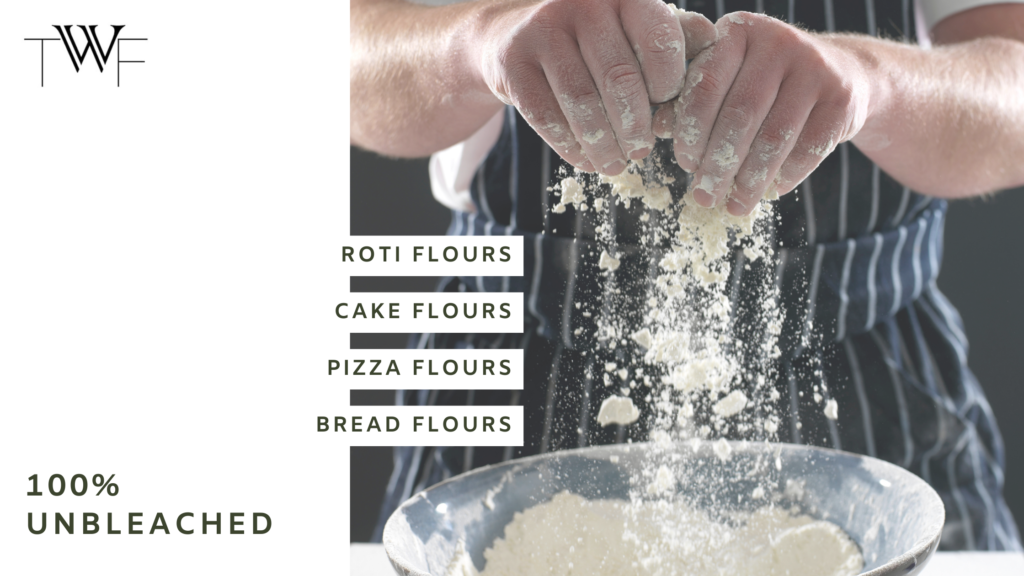Bleached vs. Unbleached Flours: What’s the Difference & Which Should You Choose?

Flour is a staple ingredient in baking and cooking, but not all flours are created equal. One of the most common distinctions you’ll encounter when choosing flour is whether it is bleached or unbleached. Understanding the differences between these two types of flour can help you make informed decisions for your baking/ cooking needs. In this blog, we’ll dive into the key differences between bleached and unbleached flours, their impact on your baked goods, and why TWF proudly offers only unbleached options.
What is Bleached Flour?
Bleached flour is treated with chemical agents like chlorine gas, benzoyl peroxide, or other bleaching agents to speed up the aging process and whiten the flour. This treatment alters the flour’s protein structure, making it softer and finer. The primary goal of bleaching is to produce a flour that has a consistent, bright white color and a finer texture, which is often preferred for products like cakes, pastries, and other delicate baked goods.
What is Unbleached Flour?
Unbleached flour, on the other hand, is not chemically treated and is allowed to age naturally after milling. This natural aging process strengthens the gluten proteins, resulting in a denser and more robust flour. While it may not have the bright white color of bleached flour, unbleached flour retains more of its natural nutrients and flavor.
Bleached vs. Unbleached Flour: How They Affect Baking
The choice between bleached and unbleached flour can significantly impact the outcome of your baked goods. Here’s how based on texture and structure, color and flavor of the baked goods.
Texture and Structure:
Bleached Flour: The soft and fine texture of bleached flour makes it ideal for light and airy baked goods like cakes, cookies, and pastries. The reduced gluten formation means these baked goods will have a tender crumb and a delicate texture.
Unbleached Flour: The denser texture of unbleached flour is perfect for recipes that require more structure, such as bread, pizza dough, and certain types of cookies. The stronger gluten network provides the necessary strength and elasticity.
Color:
Bleached Flour: Produces a bright white color, which is often desirable for cakes and pastries that are expected to have a lighter appearance.
Unbleached Flour: The off-white color of unbleached flour may result in a slightly darker baked product. However, this natural hue is often associated with a more rustic and artisanal look.
Flavor:
Bleached Flour: While some may not notice a difference, others may detect a slight chemical aftertaste in bleached flour. This can be a drawback in recipes where the flour’s flavor is more pronounced.
Unbleached Flour: Often has a richer, more natural flavor, making it ideal for recipes where the flour is a prominent ingredient.

Why TWF Flours Are Unbleached
At TWF Flours, we believe in providing the highest quality, natural products for your baking needs. That’s why we offer only unbleached flours. Here’s why we stand by this choice:
- Natural and Pure: Our flours are free from chemical treatments, ensuring that you’re baking with the purest ingredients possible. We believe that the natural aging process not only enhances the flavor of the flour but also preserves its nutritional integrity.
- Better Nutritional Value: Unbleached flour retains more of its natural nutrients, including essential vitamins and minerals that are often diminished in the bleaching process. This means you’re not only getting better-tasting baked goods but also a more wholesome product.
- Superior Flavor: The rich, complex flavor of unbleached flour elevates your baked goods, allowing the true taste of the wheat to shine through. Whether you’re baking bread, cakes, or cookies, our unbleached flours provide a superior taste experience.
- Commitment to Quality: Our commitment to using unbleached flour reflects our dedication to quality and sustainability. We prioritize traditional milling techniques and natural processes to ensure that our flours meet the highest standards.
Using TWF Unbleached Flours
Our range of unbleached flours is versatile and suited for a variety of cooking and baking applications, helping you achieve the perfect texture and flavor in your creations:
1. Roti Flour: Our unbleached flour is ideal for making soft, pliable rotis and other flatbreads. The natural strength of the flour ensures that your rotis puff up beautifully while retaining a rich, authentic flavor.
2. Cake Flour: For delicate cakes and pastries, our unbleached flour provides a soft, tender crumb while preserving more flavor and nutrition than bleached alternatives. Whether it’s a fluffy sponge cake or a rich pound cake, our flour ensures a superior baking experience.
3. Bread Flour: Perfect for artisanal breads, our unbleached flour offers good gluten development needed for a well-structured crumb and crispy crust. From rustic sourdough to fluffy sandwich loaves, this flour brings out the best in your bread recipes.
4. Pizza Flour: Our finely milled, high-protein unbleached flour is the go-to choice for crafting authentic, airy, and flavorful pizzas. Whether you’re aiming for a classic Neapolitan or a crisp thin-crust, this flour ensures that your pizza dough is easy to work with and bakes up perfectly.
Conclusion
When it comes to choosing between bleached and unbleached flour, the decision ultimately depends on your baking goals. However, at TWF Flours, we believe that unbleached flour offers superior flavor, texture, and nutritional value, making it the best choice for most baking applications. Whether you’re a professional baker or a home enthusiast, our unbleached flours are crafted to help you achieve the best possible results in your baking.
Explore our range of unbleached flours at TWF Flours and experience the difference in your baking today!


Responses